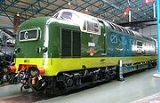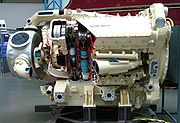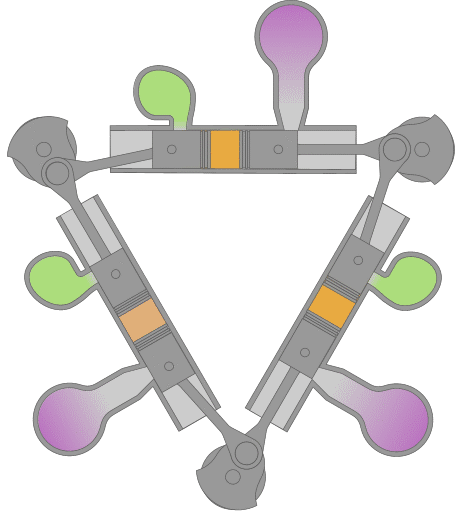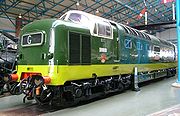
Napier Deltic
Encyclopedia

Diesel engine
A diesel engine is an internal combustion engine that uses the heat of compression to initiate ignition to burn the fuel, which is injected into the combustion chamber...
used in marine and locomotive applications, designed and produced by Napier & Son
Napier & Son
D. Napier & Son Limited was a British engine and pre-Great War automobile manufacturer and one of the most important aircraft engine manufacturers in the early to mid-20th century...
. The cylinders were divided in three blocks in a triangular arrangement, the blocks forming sides with crankcases located in each apex of the triangle.
The term Deltic (meaning in the form of the Greek letter Delta
Delta (letter)
Delta is the fourth letter of the Greek alphabet. In the system of Greek numerals it has a value of 4. It was derived from the Phoenician letter Dalet...
) is used to refer to both the Deltic E.130 opposed-piston high-speed diesel engine and the locomotives produced by English Electric
English Electric
English Electric was a British industrial manufacturer. Founded in 1918, it initially specialised in industrial electric motors and transformers...
using these engines, including their demonstrator locomotive named DELTIC
British Rail DP1
DP1, known as Deltic from the name painted on the sides, is a prototype demonstrator locomotive employing a Deltic engine, built by English Electric in 1955...
and the production version for British Railways, who designated these as (TOPS
TOPS
Total Operations Processing System, or TOPS, is a computer system for managing the locomotives and rolling stock owned by a rail system...
) Class 55
British Rail Class 55
The British Rail Class 55 is a class of diesel locomotive built in 1961 and 1962 by English Electric. They were designed for the high-speed express passenger services on the East Coast Main Line between and Edinburgh. They gained the name "Deltic" from the prototype locomotive, DP1 Deltic, which...
.
A single half-sized, turbocharged Deltic power unit also featured in the English Electric-built Type 2 locomotive, designated as the Class 23
British Rail Class 23
The British Rail Class 23 were a class of ten Bo-Bo diesel-electric locomotives built by the English Electric Company in 1959. The power unit used was a Napier Deltic T9-29 9-cylinder engine of driving an EE generator, which powered the four traction motors...
. Both locomotive and engine became better known as the "Baby Deltic
British Rail Class 23
The British Rail Class 23 were a class of ten Bo-Bo diesel-electric locomotives built by the English Electric Company in 1959. The power unit used was a Napier Deltic T9-29 9-cylinder engine of driving an EE generator, which powered the four traction motors...
".
History and design
The Deltic story began in 1943 when the British AdmiraltyAdmiralty
The Admiralty was formerly the authority in the Kingdom of England, and later in the United Kingdom, responsible for the command of the Royal Navy...
set up a committee to develop a high-power, lightweight diesel engine
Diesel engine
A diesel engine is an internal combustion engine that uses the heat of compression to initiate ignition to burn the fuel, which is injected into the combustion chamber...
for Motor Torpedo Boat
Motor Torpedo Boat
Motor Torpedo Boat was the name given to fast torpedo boats by the Royal Navy, and the Royal Canadian Navy.The capitalised term is generally used for the Royal Navy boats and abbreviated to "MTB"...
s. Hitherto in the Royal Navy
Royal Navy
The Royal Navy is the naval warfare service branch of the British Armed Forces. Founded in the 16th century, it is the oldest service branch and is known as the Senior Service...
, such boats had been driven by petrol engine
Petrol engine
A petrol engine is an internal combustion engine with spark-ignition, designed to run on petrol and similar volatile fuels....
s but this fuel is highly flammable, making them vulnerable to fire, and at a disadvantage compared with the German
Germany
Germany , officially the Federal Republic of Germany , is a federal parliamentary republic in Europe. The country consists of 16 states while the capital and largest city is Berlin. Germany covers an area of 357,021 km2 and has a largely temperate seasonal climate...
diesel-powered E-boat
E-boat
E-boats was the designation for Motor Torpedo Boats of the German Navy during World War II. It is commonly held that the E stood for Enemy....
s.
Until this time, diesel engines had poor power-to-weight ratio
Power-to-weight ratio
Power-to-weight ratio is a calculation commonly applied to engines and mobile power sources to enable the comparison of one unit or design to another. Power-to-weight ratio is a measurement of actual performance of any engine or power sources...
and low speed. Before the war, Napier had been working on an aviation diesel design known as the Culverin
Napier Culverin
-Bibliography:* Lumsden, Alec. British Piston Engines and their Aircraft. Marlborough, Wiltshire: Airlife Publishing, 2003. ISBN 1-85310-294-6.-External links:*...
after licensing versions of the Junkers Jumo 204
Junkers Jumo 204
-Bibliography:* Gunston, Bill. World Encyclopedia of Aero Engines. Cambridge, England. Patrick Stephens Limited, 1989. ISBN 1-85260-163-9* Jane's Fighting Aircraft of World War II. London. Studio Editions Ltd, 1989. ISBN 0-517-67964-7-External links:*...
. The Culverin was an opposed-piston two-stroke design. Instead of each cylinder having a single piston and being closed at one end with a cylinder head
Cylinder head
In an internal combustion engine, the cylinder head sits above the cylinders on top of the cylinder block. It closes in the top of the cylinder, forming the combustion chamber. This joint is sealed by a head gasket...
, the Jumo-based design used an elongated cylinder containing two pistons moving in opposite directions towards the centre. This negates the need for a heavy cylinder head
Cylinder head
In an internal combustion engine, the cylinder head sits above the cylinders on top of the cylinder block. It closes in the top of the cylinder, forming the combustion chamber. This joint is sealed by a head gasket...
, as the opposing piston filled this role. On the downside, the layout required separate crankshafts on either end of the engine, and some form of gearing to take off power and combine it back into a single shaft. The primary advantage of the design was that it led to a rather "flat" engine, intended to be buried in the wings of large aircraft.

Crankshaft
The crankshaft, sometimes casually abbreviated to crank, is the part of an engine which translates reciprocating linear piston motion into rotation...
s, one at each apex. The crankshafts were connected with phasing gears to drive one output shaft. In this arrangement, there were six banks of pistons driving three crankshafts, the same as three separate V-engines of the same overall size. Various models of Deltic engine could be produced with varying numbers of cylinders, though nine and eighteen cylinders were the most common, having three and six cylinders per bank respectively. In 1946, the Admiralty placed a contract with the English Electric Company, parent of Napier, to develop this engine.
One feature of the engine was the way the crankshaft-phasing was arranged to allow for exhaust port lead and inlet port lag. These engines are called 'uniflow' designs because the flow of gas into and out of the cylinder is one way, assisted by mild supercharging to improve cylinder exhaust scavenging
Scavenging (automotive)
In automotive usage, scavenging is the process of pushing exhausted gas-charge out of the cylinder and drawing in a fresh draught of air ready for the next cycle....
. The inlet/outlet port order is In/Out/In/Out/In/Out going around the triangular ring (i.e. the inlet and outlet manifold arrangements have C3
Symmetry group
The symmetry group of an object is the group of all isometries under which it is invariant with composition as the operation...
rotational symmetry
Rotational symmetry
Generally speaking, an object with rotational symmetry is an object that looks the same after a certain amount of rotation. An object may have more than one rotational symmetry; for instance, if reflections or turning it over are not counted, the triskelion appearing on the Isle of Man's flag has...
).
Earlier attempts at designing such an engine failed because of the difficulty in arranging the pistons to move in the correct manner, for all three cylinders in one delta, and this was the problem which caused Junkers Motorenbau
Junkers
Junkers Flugzeug- und Motorenwerke AG , more commonly Junkers, was a major German aircraft manufacturer. It produced some of the world's most innovative and best-known airplanes over the course of its fifty-plus year history in Dessau, Germany. It was founded there in 1895 by Hugo Junkers,...
to leave behind work on the delta-form while continuing to prototype of a diamond-form four-crankshaft 24-cylinder Junkers Jumo 223
Junkers Jumo 223
The Junkers Jumo 223 was an experimental 24-cylinder aircraft engine based on the Junkers Jumo 205. Like the Jumo 205, it was an opposed piston two-stroke diesel engine. It had four banks of six cylinders in a rhomboid configuration, with four crankshafts one at each vertex of the rhombus, and 48...
. Mr. N. Penwarden of the Admiralty Engineering Laboratory solved this problem by suggesting that one crankshaft needed to revolve anti-clockwise to achieve the correct piston-phasing, so Napier designers produced the necessary gearing in order that one of them rotated in the opposite direction to the other two.
In an opposed-piston design with no inlet or exhaust valves, and no ability to vary the port positions, the Deltic design arranged each crankshaft to connect two adjacent pistons operating in different cylinders in the same plane, using "fork and blade" connecting rods, the latter an 'inlet' piston used to open and close the inlet port, and the former an 'exhaust' piston in the adjacent cylinder to open and close the exhaust port.
Crankshaft connecting-rod journals were arranged so that each cylinder's exhaust piston 'led' its inlet piston by 20 degrees of crankshaft rotation. This allowed the exhaust port to be opened well before the inlet port, and allowed the inlet port to be closed after the exhaust port, which led to both good scavenging of exhaust gas, and good volumetric efficiency for the fresh air charge. It also led to Deltics' even, buzzing exhaust note, with a charge ignition every 20 degrees of crankshaft revolution, and a lack of torsional vibration, ideal for use in mine-hunting vessels.
Although the engine was cylinder-ported and required no poppet valves, it did still have camshafts, with each bank having a separate camshaft, driven at crankshaft speed. This was used solely to drive the fuel injection pumps, each cylinder having its own injector and pump, driven by its own cam lobe.
Naval service
_-_portsmouth_2007_-_bb.jpg)
E-boat
E-boats was the designation for Motor Torpedo Boats of the German Navy during World War II. It is commonly held that the E stood for Enemy....
powered by three Mercedes-Benz diesel engines, was selected for these trials, since its power units were of approximately equal power to the new 18-cylinder Deltic engines. Two of the three Mercedes-Benz engines were replaced with Napier Deltics, the compactness of the Deltic being graphically illustrated: they were half the size of the original engines. The Deltic weighed one fifth of its contemporaries of equivalent power.
Proving successful, Deltic diesel engines became a common powerplant in small and fast naval craft. The Royal Navy
Royal Navy
The Royal Navy is the naval warfare service branch of the British Armed Forces. Founded in the 16th century, it is the oldest service branch and is known as the Senior Service...
used them first in the Dark class
Dark class fast patrol boat
The Dark class, or Admiralty "Type A", were a class of eighteen fast patrol boats that served with the United Kingdom's Royal Navy starting in 1954. All were named with a prefix of 'Dark'. The class could be fitted as either motor gun boats or motor torpedo boats, depending on the type of armament...
fast attack craft. Subsequently they were used in a number of other smaller attack craft. The low magnetic signature lent itself to use in mine countermeasures vessel
Mine countermeasures vessel
A mine countermeasures vessel or MCMV is a type of naval ship designed for the location of and destruction of naval mines which combines the role of a minesweeper and minehunter in one hull. The term MCMV is also applied collectively to minehunters and minesweepers....
s and the Deltic was selected to power the Ton class
Ton class minesweeper
The Ton class were coastal minesweepers built in the 1950s for the Royal Navy, but also used by other navies such as the South African Navy and the Royal Australian Navy...
minesweeper. The Deltic engine is still in service in the Hunt class. These versions are de-rated to reduce engine stress.
Deltic diesels served in MTBs and PT boat
PT boat
PT Boats were a variety of motor torpedo boat , a small, fast vessel used by the United States Navy in World War II to attack larger surface ships. The PT boat squadrons were nicknamed "the mosquito fleet". The Japanese called them "Devil Boats".The original pre–World War I torpedo boats were...
s built for other navies. Particularly notable was the Norwegian
Norway
Norway , officially the Kingdom of Norway, is a Nordic unitary constitutional monarchy whose territory comprises the western portion of the Scandinavian Peninsula, Jan Mayen, and the Arctic archipelago of Svalbard and Bouvet Island. Norway has a total area of and a population of about 4.9 million...
Tjeld or Nasty class
Tjeld class patrol boat
The Tjeld class were a class of fast patrol boats designed in Norway. They were used as torpedo boats in Norway where this type of vessel were called MTBs or motor torpedo boats . The class was also known as the Nasty class....
, which was also sold to Germany, Greece, and the United States Navy
United States Navy
The United States Navy is the naval warfare service branch of the United States Armed Forces and one of the seven uniformed services of the United States. The U.S. Navy is the largest in the world; its battle fleet tonnage is greater than that of the next 13 largest navies combined. The U.S...
. Nasty class boats served in the Vietnam War
Vietnam War
The Vietnam War was a Cold War-era military conflict that occurred in Vietnam, Laos, and Cambodia from 1 November 1955 to the fall of Saigon on 30 April 1975. This war followed the First Indochina War and was fought between North Vietnam, supported by its communist allies, and the government of...
, largely for covert operations.
Smaller nine-cylinder Deltic 9 engines were used as marine engines, notably by minesweepers. The Ton class
Ton class minesweeper
The Ton class were coastal minesweepers built in the 1950s for the Royal Navy, but also used by other navies such as the South African Navy and the Royal Australian Navy...
vessels were powered by a pair of Deltic 18s and used an additional Deltic 9 for power generation for their magnetic influence sweep. The Hunt class
Hunt class MCMV
The Hunt class is a class of thirteen mine countermeasure vessels of the Royal Navy. They combine the separate role of the traditional minesweeper and that of the active minehunter in one hull...
used three Deltic 9s, two for propulsion and again one for power generation, but this time with a hydraulic pump integrated as well to power bow-thrusters for slow-speed manœuvring.
Railway use

The 'Deltic' engines were used in two types of British rail locomotive: classes 55 and 23, built in the 1960s. Because of their engines, these types were nicknamed "Deltics" and "Baby Deltics" respectively.
The Class 55 used two D18-25 Deltic engines: mechanically-blown 18-cylinder engines of 1650 hp each, the Class 23 used a single less powerful nine-cylinder turbocharged T9-29 Deltic of 1100 hp.
Reliability in service
While the Deltic engine was successful and very powerful for its size and weight, it was a highly-strung unit, requiring careful maintenance. This led to a policy of unit replacement rather than repair in situ. Deltic engines were easily removed after breakdown, generally being sent back to the manufacturer for repair, although after initial contracts expired both the Royal Navy and British Railways set up their own workshops for overhauls.Turbo-compound Deltic
The E.185 or Compound Deltic turbo-compoundTurbo-compound engine
A turbo-compound engine is a reciprocating engine that employs a blowdown turbine to recover energy from the exhaust gases. The turbine is usually mechanically connected to the crankshaft but electric and hydraulic systems have been investigated as well. The turbine increases the output of the...
variant was planned and a single prototype was built in 1956 and tested in 1957. This capitalised on Napier's experience with both the Nomad
Napier Nomad
The Napier Nomad was a complex British compression-ignition aircraft engine designed and built by Napier & Son in 1949. Two versions were flight tested:...
and their increasing involvement with gas turbine
Gas turbine
A gas turbine, also called a combustion turbine, is a type of internal combustion engine. It has an upstream rotating compressor coupled to a downstream turbine, and a combustion chamber in-between....
s. It used the Deltic as the gas generator
Gas generator
A gas generator usually refers to a device, often similar to a solid rocket or a liquid rocket that burns to produce large volumes of relatively cool gas, instead of maximizing the temperature and specific impulse. The low temperature allows the gas to be put to use more easily in many...
inside a gas turbine, with both a twelve-stage axial compressor
Axial compressor
Axial compressors are rotating, airfoil-based compressors in which the working fluid principally flows parallel to the axis of rotation. This is in contrast with other rotating compressors such as centrifugal, axi-centrifugal and mixed-flow compressors where the air may enter axially but will have...
and a three stage gas turbine. Unlike the Nomad, this turbine was not mechanically coupled to the crankshaft but merely drove the compressor. It was hoped to produce 6,000 horsepower, with fuel economy and power-to-weight ratio "second to none". Predictions by the engineers closely connected with it were that connecting rod failure would be the limit on this power, failing at around 5,300 bhp. On test it actually produced 5,600 bhp, before throwing a connecting rod through the crankcase just as predicted. Naval interest had waned by 1958 in favour of the pure gas turbine, despite its heavier fuel consumption, and no further development was carried out.
External links
- Deltic technical details.
- The Deltic Preservation Society.
- Hunt Class Deltic powered Mine Countermeasure Vessel.
- Deltic Animations 3-D animations of the piston motion in the Deltic engine.

